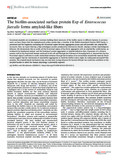Mostrar el registro sencillo del ítem
The biofilm-associated surface protein Esp of Enterococcus faecalis forms amyloid-like fibers
| dc.creator | Taglialegna, Agustina | es_ES |
| dc.creator | Matilla Cuenca, Leticia | es_ES |
| dc.creator | Dorado Morales, Pedro | es_ES |
| dc.creator | Navarro, Susanna | es_ES |
| dc.creator | Ventura, Salvador | es_ES |
| dc.creator | Garnett, James A. | es_ES |
| dc.creator | Lasa Uzcudun, Íñigo | es_ES |
| dc.creator | Valle Turrillas, Jaione | es_ES |
| dc.date.accessioned | 2020-08-05T06:00:28Z | |
| dc.date.available | 2020-08-05T06:00:28Z | |
| dc.date.issued | 2020 | |
| dc.identifier.issn | 2055-5008 | |
| dc.identifier.uri | https://hdl.handle.net/2454/37658 | |
| dc.description.abstract | Functional amyloids are considered as common building block structures of the biofilm matrix in different bacteria. In previous work, we have shown that the staphylococcal surface protein Bap, a member of the Biofilm-Associated Proteins (BAP) family, is processed and the fragments containing the N-terminal region become aggregation-prone and self-assemble into amyloid-like structures. Here, we report that Esp, a Bap-orthologous protein produced by Enterococcus faecalis, displays a similar amyloidogenic behavior. We demonstrate that at acidic pH the N-terminal region of Esp forms aggregates with an amyloid-like conformation, as evidenced by biophysical analysis and the binding of protein aggregates to amyloid-indicative dyes. Expression of a chimeric protein, with its Esp N-terminal domain anchored to the cell wall through the R domain of clumping factor A, showed that the Esp N-terminal region is sufficient to confer multicellular behavior through the formation of an extracellular amyloid-like material. These results suggest that the mechanism of amyloid-like aggregation to build the biofilm matrix might be widespread among BAP-like proteins. This amyloid-based mechanism may not only have strong relevance for bacteria lifestyle but could also contribute to the amyloid burden to which the human physiology is potentially exposed. | en |
| dc.description.sponsorship | This research was supported by grants RTI2018-096011-B-I00 and BIO2017-83035-R from the Spanish Ministry of Science, Innovation and Universities, and Proyecto Intramural Incorporación-2018 CSIC. | en |
| dc.format.extent | 12 p. | |
| dc.format.mimetype | application/pdf | en |
| dc.language.iso | eng | en |
| dc.publisher | Nature Research | en |
| dc.publisher | Nanyang Technological University (Singapur) | en |
| dc.relation.ispartof | npj Biofilms and Microbiomes, 2020, 6: 15 | en |
| dc.rights | © The Author(s) 2020. This article is licensed under a Creative Commons Attribution 4.0 International License, which permits use, sharing, adaptation, distribution and reproduction in any medium or format, as long as you give appropriate credit to the original author(s) and the source, provide a link to the Creative Commons license, and indicate if changes were made. The images or other third party material in this article are included in the article’s Creative Commons license, unless indicated otherwise in a credit line to the material. If material is not included in the article’s Creative Commons license and your intended use is not permitted by statutory regulation or exceeds the permitted use, you will need to obtain permission directly from the copyright holder. | en |
| dc.rights.uri | http://creativecommons.org/licenses/by/4.0/ | |
| dc.subject | Biofilms | en |
| dc.subject | Microbiome | en |
| dc.title | The biofilm-associated surface protein Esp of Enterococcus faecalis forms amyloid-like fibers | en |
| dc.type | info:eu-repo/semantics/article | en |
| dc.type | Artículo / Artikulua | es |
| dc.contributor.department | Ciencias de la Salud | es_ES |
| dc.contributor.department | Osasun Zientziak | eu |
| dc.rights.accessRights | info:eu-repo/semantics/openAccess | en |
| dc.rights.accessRights | Acceso abierto / Sarbide irekia | es |
| dc.identifier.doi | 10.1038/s41522-020-0125-2 | |
| dc.relation.projectID | info:eu-repo/grantAgreement/AEI/Plan Estatal de Investigación Científica y Técnica y de Innovación 2013-2016/BIO2017-83035-R/ES/ | en |
| dc.relation.publisherversion | https://doi.org/10.1038/s41522-020-0125-2 | |
| dc.type.version | info:eu-repo/semantics/publishedVersion | en |
| dc.type.version | Versión publicada / Argitaratu den bertsioa | es |
Ficheros en el ítem
Este ítem aparece en la(s) siguiente(s) colección(ones)
La licencia del ítem se describe como © The Author(s) 2020. This article is licensed under a Creative Commons Attribution 4.0 International License, which permits use, sharing, adaptation, distribution and reproduction in any medium or format, as long as you give appropriate credit to the original author(s) and the source, provide a link to the Creative
Commons license, and indicate if changes were made. The images or other third party material in this article are included in the article’s Creative Commons license, unless
indicated otherwise in a credit line to the material. If material is not included in the article’s Creative Commons license and your intended use is not permitted by statutory
regulation or exceeds the permitted use, you will need to obtain permission directly from the copyright holder.




